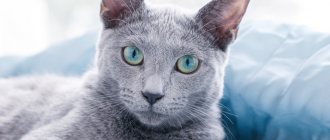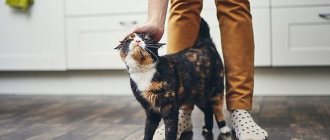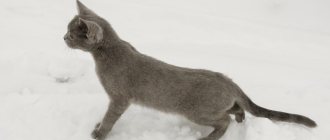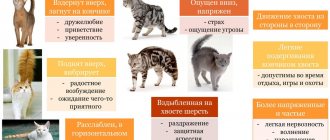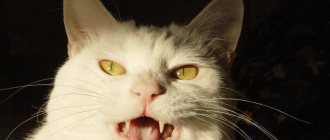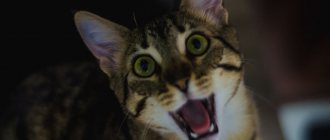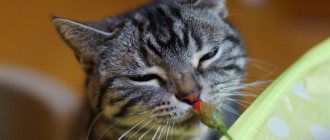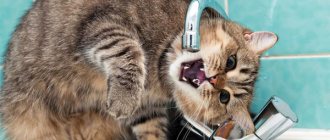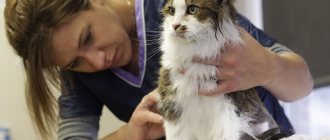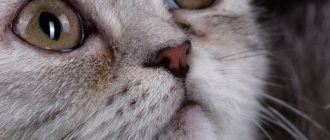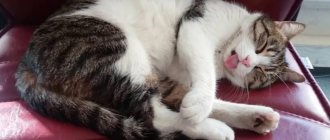Scottish cats have a medium, but rather dense, build when compared to other breeds. They have thinner and lighter bones than their closest relatives, the British, but they should still resemble teddy bears. From time to time, owners are faced with the problem that their Scottish cat is thin or their Scottish kitten is not growing well. Let's figure out why this happens.
Determining the norm
Before we understand what to do, let's understand what a skinny Scottish cat or skinny Scottish cat is. Many owners suffer that their animal is not fat enough, although, in fact, its weight is within the normal range. So first, check out the normal weight chart for a Scottish cat. Of course, you need to pay attention not only to weight, but also to height: what is a lot for one animal, is not enough for another. But the general rule is this: if a cat’s pelvic bones and ribs are visible, you should sound the alarm and solve the problem urgently.
Article continues after advertisement
On the left is a normal Scottish cat, in the center is a slender cat, on the right is a cat with malnutrition
Well, now let's look at the main reasons why the Scottish cat is thin.
What to do:
- in all cases of abdominal enlargement, it is necessary to consult a doctor, regardless of the age of the animal - there are no options for “it will resolve on its own”!
– the faster the belly enlarges, the more urgent it should be to see a doctor. If there is a simultaneous significant deterioration in your health, you must go immediately to the clinic, where an ultrasound/X-ray and, if necessary, surgery can be performed.
– to independently monitor the amount of fluid in the abdominal cavity, you can use weighing + measuring the volume of the abdomen with a centimeter tape. Nevertheless, primary importance when choosing treatment tactics is given to the general condition of the animal and the degree of tension in the abdominal wall, and not to weight/volume.
Genetic miniature
Experienced breeders build genetic lines so that one of the main characteristics of the breed - resemblance to a teddy bear - is well developed. The situation is completely different with pets that are bred without permission, pedigrees and prior training in felinological courses. From incorrect crossbreeding you can get Scots with an insufficiently dense physique and a host of other shortcomings. If your cat is not so much thin as miniature, there’s nothing you can do about it: genes take their toll.
One of the common reasons why a Scottish cat is thin, or rather too petite and slender for a Scot, is that its breed is unclean - there are some impurities. The kitten could have been sold as a Scottish one, but it did not grow up quite as expected, because... This kitten is a mixed breed. Or, perhaps, he was born from two parents, one or two of whom had other breeds in the family. If so, then there is no need to try to make the cat fatter. If her ribs are not visible and when palpated the cat does not resemble a washboard, then she has a normal constitution for her genetic type.
Alarming symptoms
If the cat is very thin, first of all it is necessary to observe his condition and behavior. The following symptoms should cause concern :
- unpleasant odor from the mouth;
- lethargy, decreased activity and apathetic state;
- increased body temperature;
- diarrhea or constipation, vomiting;
- purulent discharge from the eyes;
- refusal of food.
These signs can occur with helminthic infestation, infections, gastrointestinal disorders and other serious diseases. If one or more symptoms are detected, the animal should be examined by a veterinarian.
© shutterstock
Unbalanced diet
No matter how trivial, but most often the reason for the thinness of a Scottish cat is poor nutrition. The cat does not receive enough vitamins and microelements, as well as protein, and therefore muscle and fat mass are insufficient. Let us remind you that cats must receive meat and protein daily in an amount of at least 70-80% of the diet, and preferably 90%. It is from meat that the cat receives most of the nutrients the body needs.
And under no circumstances should you stuff it exclusively with pasta and vegetables, adding only a little meat. However, pasta and cereals, even in small quantities, often lead to the kitten not gaining weight: most cats do not have a good relationship with grains (cereals interfere with the absorption of nutrients from other foods), so it is better to exclude them from the diet.
Often the problem of unbalanced nutrition is low-quality ready-made factory feed: this is the majority of feed that is sold in supermarkets. If you give your cat food, it should only be premium and super premium. Although, it is worth noting that often good premium food is simply not suitable for a kitten, as a result of which it does not gain weight.
“We had a weak, thin, fold-eared kitten. We adopted him when he was 3 months old; before that he lived in a nursery with a professional breeder, i.e. There shouldn't be any problems. His brothers and sisters were also not very plump, but this one was completely thin and weak. At 3 months I weighed 1 kg! At the nursery he was fed Royal Canin. My animals are all natural, so in any case we planned to switch him to meat. I generally have a bad attitude towards food. But, on the other hand, I understand that cats have been growing up on Royal for generations - and everything is fine with them. Therefore, I think that the reason was that this particular cat’s body did not accept this food, and perhaps it would not have accepted other foods either. He ate normal portions, but was skin and bones. In general, in the very first days we switched him to raw meat. More precisely, he transferred himself by stealing food from an adult cat. And what do you think? After 2 weeks he already weighed 1.5 kg. The rate of weight gain, of course, is too high, but it turned out how it turned out. At 4 months it was already 2.5 kg, at 5 months - 3.2 kg. Matured. He became well-fed. No protruding ribs or spine. This is how proper nutrition works wonders,” says Ekaterina, the owner of a Highland Fold cat.
Read more about what to feed your Scottish cat.
Diagnostics and therapy
To make a diagnosis, blood, urine and feces are examined, ultrasound and x-rays are done. During the examination, the veterinarian palpates and listens to the peritoneum. Depending on the results that explain why the cat has a hard stomach, the doctor decides what to do to normalize his condition.
Help with non-dangerous causes of bloating
Flatulence caused by poor nutrition can be eliminated by adjusting the diet. A ban is imposed on any products that increase gas formation (legumes, flour, fresh vegetables). Remember that milk is contraindicated for adult animals, as they develop lactose intolerance. To normalize intestinal function, your veterinarian may recommend a course of probiotics.
Excessive weight can be eliminated by reviewing your diet. The animal is prescribed less high-calorie food and the usual portions are reduced. Daily physical activity is complemented by joint games.
A big belly in a scared cat can be healed with time. Do not impose your affection and let your pet get used to the unfamiliar environment.
Treatment of the underlying disease
Surgery will be required to eliminate pyometra. During the operation, the veterinarian cuts out the uterus, that is, performs sterilization. Surgeries are also necessary to remove a tumor, intestinal obstruction, foreign object, or the consequences of severe trauma.
All infectious diseases are treated with antibiotics and antiviral drugs, and helminthiasis with anthelmintics. Intoxication with poisons is eliminated by administering an antidote and gastric lavage. In case of ascites, excess fluid is pumped out of the animal and a course of diuretics is prescribed.
To treat constipation, use Vaseline oil or laxatives. Such therapy is permissible only in the absence of intestinal obstruction. Otherwise, taking these drugs may cause intestinal rupture.
Treatment for an abscess depends on its complexity. Most often, drug therapy, which involves taking antibiotics and anti-inflammatory drugs, is sufficient. In case of extensive inflammation, the ulcers are removed by a surgeon.
Cholecystitis is treated with antibiotics and proper nutrition. The animal is transferred to a veterinary food that fights gallstones.
Any therapy must be carried out under the supervision of a veterinarian, with dosages clearly specified by him.
Low appetite
Do you offer your cat good food, but she still doesn't eat well? There are different reasons for poor appetite. These are worms, which will be discussed below. This is also stress. This includes teething. These are behavioral problems: read about them here.
Article continues after advertisement
But most often, poor appetite is observed in uncastrated cats and unsterilized cats during rutting periods: then the desire to eat fades into the background or may practically disappear. And if estrus is frequent or the cat’s sexual desire is not systematically satisfied, then the endless rut can exhaust the body. If you plan to castrate an animal, then after the operation (about 1 month) the pet’s body will be rebuilt - and its appetite will become excellent.
Alena, owner of a Scottish Fold: “We had the problem of low weight from about 5 to 9 months. The cat was almost skinny. She didn't eat well. When they put food on her, she acted like she was doing us a favor. I ate little. At 5 months, she began to go into heat, which occurred every 2 weeks. During heat, the cat could not eat for days on end, only wailing. As a result, even veterinarians gasped that we were so thin. At 8 months she was sterilized (at that time she weighed 2.9 kg) - after 2 months the cat began to weigh 4.2 kg. We have become much plumper (but without going overboard, maybe just a little), and the appetite is such that the cat no longer goes overboard with food: she eats everything we offer. And loudly asks for food if she’s hungry, without any coquetry.”
How to properly feed a cat natural food?
The menu consists of two types of dishes. These are meat and dairy products.
The basis of the meat diet is lean beef, cut into small pieces. Next you need to provide the dish with vitamins. This can be done using vegetables or special additives . Veterinary stores sell vitamin powders that contain everything your pet needs. The compositions are not cheap, but it saves the housewife time.
The fermented milk set consists of low-fat cottage cheese and one percent kefir. On average, cottage cheese is served “on the table” to the cat 1-2 times a week.
Teenage years
Scottish cats stretch in length during adolescence, and their weight does not keep up with their height. During the ugly duckling period, they often begin to look ugly, and owners get upset, thinking that it will always be this way. There's no need to get upset. But you need to pay attention to the quality of the diet, because if a cat does not receive enough calcium, vitamins and other nutrients during adolescence, its skeleton and muscles may not form correctly - and subsequently it will not grow up to be as beautiful a cat as it could have grown up to be.
Thin kitten does not gain weight due to helminths
The remaining reasons why a kitten is thin lie in the area of diseases introduced from outside. Here, the first place is taken by helminth infection, which occurs in almost all kittens whose mothers have not undergone appropriate treatment or the treatment has not been completed. Such a kitten eats a lot, but is still thin, while its tummy can be dense and enlarged, and indigestion often occurs. Clusters of worms clog the small intestines, and intoxication due to their waste products can kill the baby.
Disease
Underweight may also indicate a serious illness. For example, disorders of the thyroid gland, resulting in hormonal imbalance. Another possible cause is diabetes. Oncology also gives a similar picture.
Let's talk separately about such a disease as anorexia of the Scottish fold and straight-eared cats. Thinness in this case is only a consequence. The reason is the lack of feeling of hunger due to impaired sense of smell (this can happen even with nasal congestion) and pathology of the digestive system.
If you've tried everything and your cat is still skinny, she may be sick with something. We need to take her to the veterinary clinic and have her thoroughly examined.
Diagnostics
Diagnosis of bloating must be comprehensive and include blood tests (general and biochemical), urine, abdominal ultrasound and x-rays. In some cases, especially if neoplasms are suspected, a CT scan is recommended.
The following are the primary diagnostic methods, depending on the suspicion of various causes of bloating:
- Obesity – weighing the pet, analyzing the diet, palpation;
- Pregnancy - ultrasound of the abdominal cavity;
- Flatulence - diet analysis, abdominal ultrasound;
- Viral disease - specific virological tests (PCR test of blood and effusion);
- Neoplasm – ultrasound of the abdominal cavity, plain X-ray in three projections, CT in the “oncology search” mode;
- Heart diseases – cardiac ECHO;
- Liver diseases - general and biochemical blood tests, ultrasound of the abdominal cavity;
- Kidney diseases - general and biochemical blood tests, abdominal ultrasound, urinalysis;
- Coprostasis – abdominal x-ray;
- Injuries – ultrasound of the abdominal cavity;
- Pyometra - ultrasound of the abdominal cavity;
- Helminthic infestation - stool analysis.
Unknown reason
It also happens that a cat is examined and no visible reasons for thinness are found. And all the measures taken do not produce results. In this case, there is still a reason for this problem, it just hasn’t been found out.
If we are talking about a young cat under 1 year of age who is developing poorly and gaining weight very sluggishly, then the drug “Catozal” (analogous to “Vetozal”) can work wonders. This drug greatly helped the thin kitten of the author of the article, who was sick all the time and was developing poorly. The veterinarian prescribed him a five-day course, and already on the second day changes began for the better: the kitten became active and stopped lying down all day. After the fifth day, changes in appearance were already noticeable. After stopping the drug, the problem did not return. But you can take this drug only after consulting a veterinarian, because it has contraindications.
Rate and share!
Is it necessary to add additional vitamins, microelements and minerals to the diet?
If a cat is fattened with commercially prepared food, then, as a rule, it does not need any additional vitamin complexes. There are some cases where the exhaustion of an animal has affected its health, and one or another vitamin may be required to correct it. Then the doctor will prescribe such a supplement in a certain proportion and for a certain period.
When a cat eats only natural food, vitamin-mineral complexes should always be present as a supplement. Veterinary pharmacies today have a fairly large selection of such drugs. But it is worth distinguishing between vitamin and mineral complexes for kittens and adult animals.
The drugs in greatest demand are:
- for kittens: GIMPET Baby-tabs;
- Beaphar Kittys junior;
- 8 in 1 Excel Brewers;
8 in 1 Excel Brewers are considered a universal complex; regular use prevents the development of vitamin deficiency and improves metabolism.
- Canina cat mineral with calcium;
- Hartz Everyday Chewable Vitamins with Taurine;
- Pharmax;
ANIVITAL products are developed based on natural ingredients and help to effectively solve many current health problems in dogs and cats.
Video: vitamins for cats and kittens
Why are kittens thin at 3 months?
Rickets in kittens. Symptoms, causes and treatment
Rickets is a serious and dangerous disease in animals. Therefore, at the first symptoms of the disease, it is necessary to seek help from specialists. Many owners try to overcome the problem on their own, using various folk remedies and recipes. But this can only lead to worsening symptoms. The more severe the form of the disease, the more difficult it is to fight it. Owners need to remember this. In order to effectively treat rickets, the doctor must find out the causes of the pathology, the complexity of the disease, how it proceeds and obtain many other data. Only with a comprehensive professional approach can you really help the animal.
The whole day is spent on the couch
In the wild, cats eat as much as they can and don’t get fat. The fact is that they are simply forced to move, getting food for themselves. In addition, they are constantly in a hostile environment, where they have to flee from larger predators. During the winter season, a lot of energy is spent on heating the body, which further increases the overall calorie expenditure.
Of course, in a city apartment it’s impossible to repeat all this, and it’s not necessary, but spending the whole day on the sofa is also not a good idea for a healthy cat. Encourage her to move with interactive toys and teases. Some cats love to play with rubber mice and chase laser pointers. Others become active in the presence of a companion. Look for what suits you.
